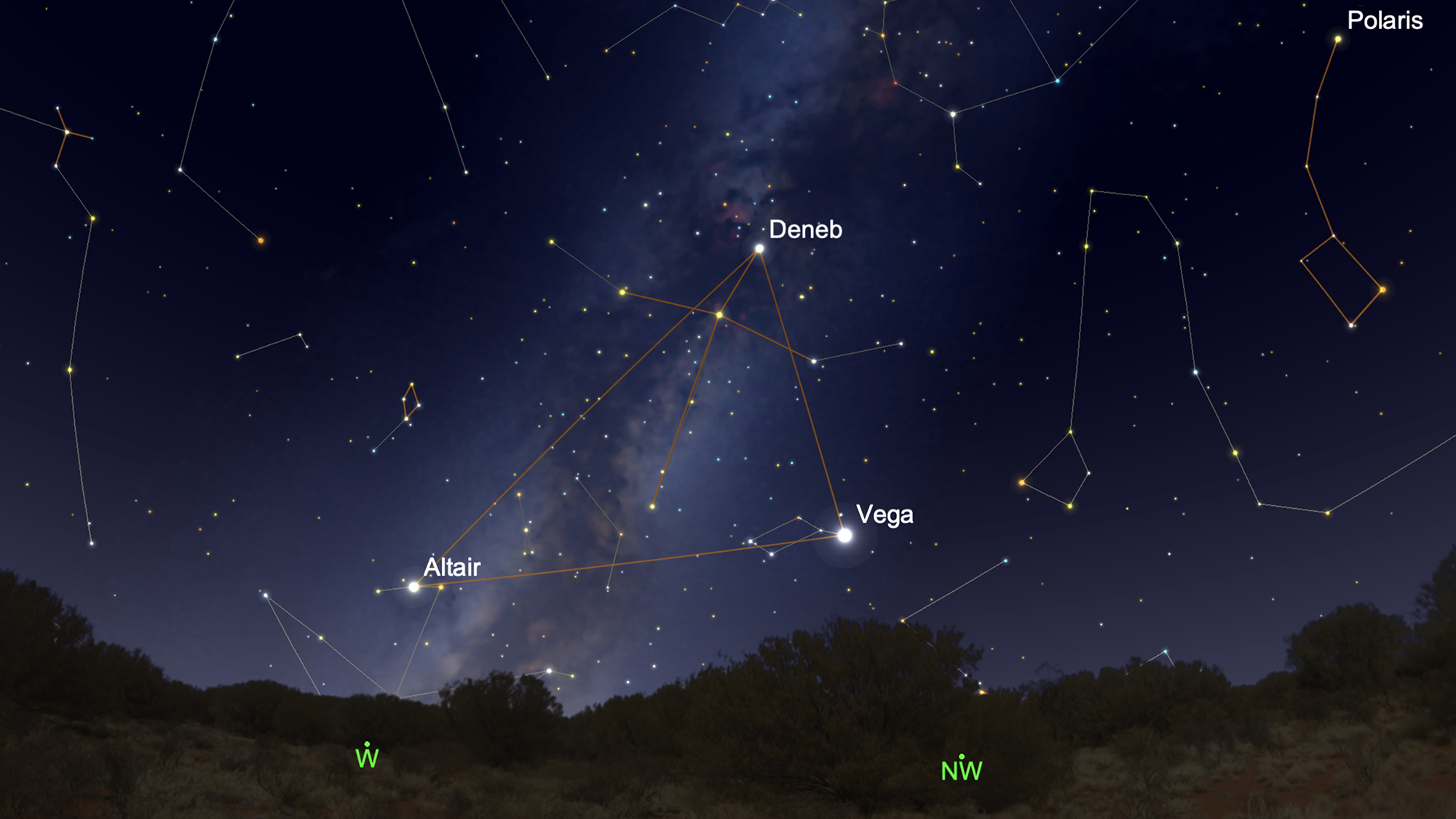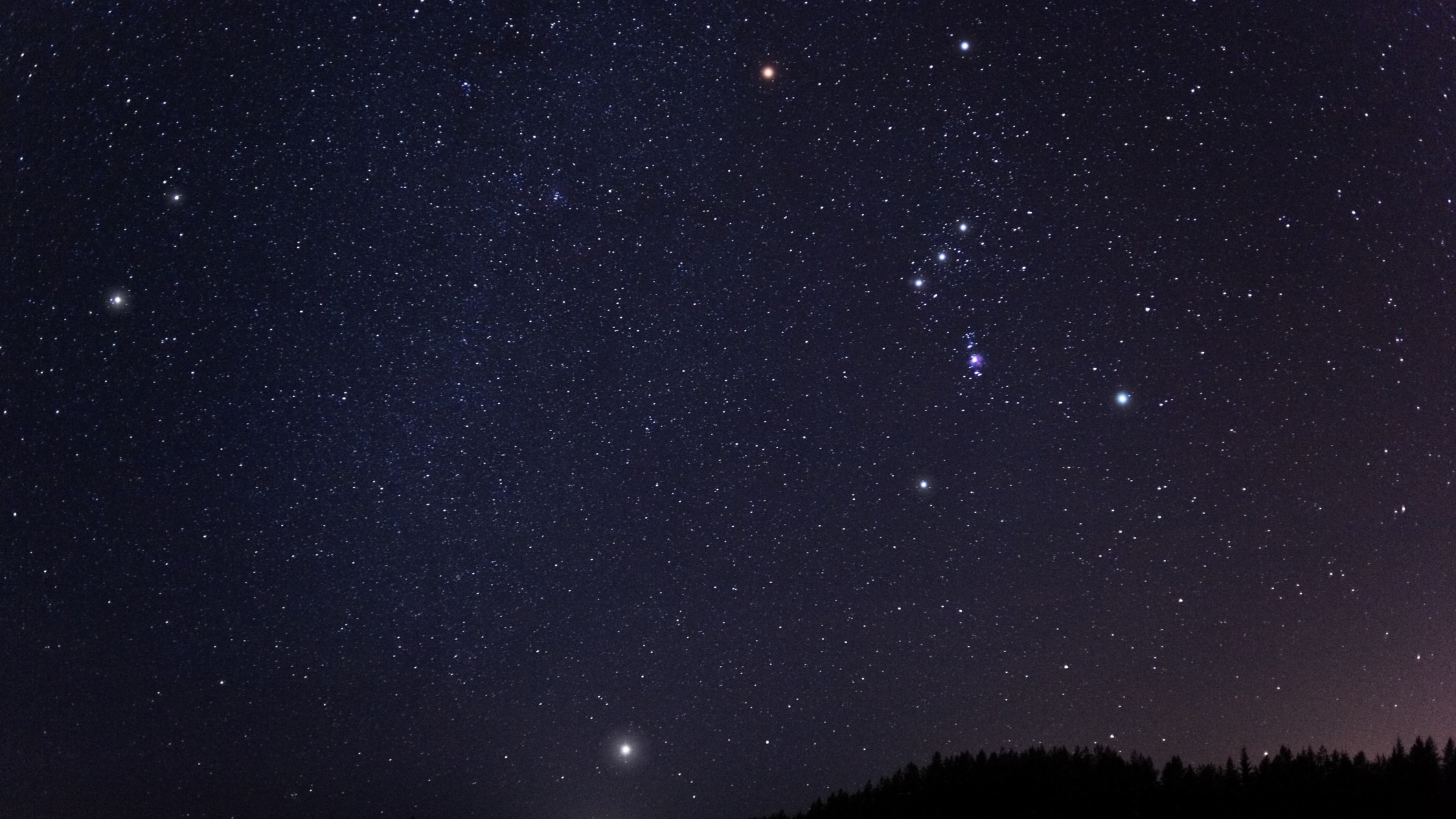
Anyone interested in astronomy realizes that the stars are scattered through three-dimensional space and not, as the ancients thought, points of light affixed to a celestial sphere. The night sky has often appeared to many as a kind of ceiling or vault.
Stars in general are distributed randomly in space. Their various patterns and configurations would look quite different if we could view them from elsewhere in our galaxy. Constellations as such, are but chance arrangements in space. But from here on Earth, we can also get the same effect by looking out over a town or village at night and taking note of how streetlights and lamps in houses can also form a "constellation."
Each light's actual intensity and its distance determine how bright it appears to the viewer. A streetlamp nearby, for instance, can be used as an analogy to Sirius, the brightest star in the sky. Indeed, the Dog Star is conspicuous mainly because it is only 8.6 light-years from us. Intrinsically, it shines about 25 times brighter than our sun. But a beacon from a distant lighthouse might appear nearly as bright as the streetlamp despite its greater distance.
Related: The biggest and brightest stars in the galaxy
Apparent magnitude vs. absolute magnitude
Take the well-known Summer Triangle, which this week stands directly over our heads at around 8:30 p.m. local daylight time. Its member stars — Deneb, Vega, and Altair — are at very unequal distances from us, making it a rather good example of how misleading the two-dimensional "vault" illusion can be.
The closest of the three is Altair, which is 16.7 light-years away, followed by Vega, at 25 light-years; but Deneb is enormously farther, at 1,400 light-years. Despite the fact that we are seeing the latter star by light that started its journey around the time the Vikings invaded Ireland, it still manages to rank as a star of the first magnitude since it is a brilliant blue supergiant, more than 100,000 times brighter than the sun.

But we cannot judge stellar brightness by comparing one star to another based on how they appear from our perspective on Earth. In comparing the intrinsic luminosity of stars that are near and far, astronomers use a scale measuring their absolute magnitudes. By definition, the absolute brightness of a star is the magnitude it would have when viewed from a distance of 32.6 light-years.
Get the Space.com Newsletter
Breaking space news, the latest updates on rocket launches, skywatching events and more!
Put another way, a parsec is a unit of distance used in astronomy, equal to 3.26 light-years (3.086 × 1013 kilometers). One parsec corresponds to the distance at which the mean radius of the Earth's orbit subtends an angle of one second of arc. So, ten parsecs — 32.6 light-years — is the "standard" distance that we would measure how luminous one star would appear as compared to others.
Were it possible to somehow move Deneb to a distance of 10 parsecs it would dazzle us with brightness more than six times greater than Venus at greatest brilliance, at a magnitude of -6.9. On the other hand, because Vega is not too much closer than 32.6 light years, its absolute brightness (0.6) differs little from its apparent (0.0).
Our mediocre sun
What about our own star, the sun? At an average distance of 92.9 million miles (149.5 million kilometers), it dazzles with a blinding apparent magnitude of -26.7. But keep in mind that compared to most other stars, the sun is nothing more than an average type star. If we could observe it from a distance of 10 parsecs, it would be a dim naked-eye object of magnitude +4.8. If you want to get an idea of just how faint this is, check out the bowl of the Little Dipper. The faintest of the four stars that make up the bowl, Eta Ursae Minoris, is just a trifle fainter at magnitude +4.9.
So, if we moved our sun out 10 parsecs from its current location, you would have difficulty identifying it against the star background without a star atlas, and if we factor in light pollution, you wouldn't be able to see it at all without binoculars or a small telescope.
From Pluto?
While we're on the subject of seeing the sun from a distant location, what would it look like from the outskirts of the solar system, say from the dwarf planet, Pluto?
From there, it is often described in astronomy books as appearing as nothing more than a "very bright star," giving an impression that it mimics Venus in the Plutonian sky. In 1960, the National Film Board of Canada produced a superb film documentary titled "Universe." In speaking of Pluto, the film's narrator, Douglas Rain (who later would supply the voice for "Hal" in the 1968 movie, "2001 A Space Odyssey") comments:
"Its surface moves in perpetual darkness and unimaginable cold, for the sun is four billion miles away, only a starry speck in the sky."
The question to be raised here is: Is this really so?
At its mean distance from the sun, Pluto is 39.4 times farther than Earth. If we use the inverse square law, the sun's brightness there is reduced by 39.4 squared, or 1,552.36. This would give us an apparent magnitude for the sun of -18.7 as seen from Pluto. Since the full moon is magnitude -12.7, the sun from Pluto would appear as bright as 400 full moons.
Hardly a "starry speck" in the sky!
Catch Orion now

If you are an early riser, then by all means you ought to set your alarm clock for around 5 a.m. and step outside and enjoy the sight of Orion, the Mighty Hunter, who currently at that hour of the morning dominates the southeastern sky. Now, before local temperatures and weather begin to get too cold and harsh, you can admire Orion and his retinue in relative comfort.
Most of the stars in this constellation are a thousand light-years or more from us. They are true galactic beacons! Alnilam, the middle star of Orion's belt, for example, is over 200,000 times as bright as the sun.

Looking for a telescope to see Jupiter? We recommend the Celestron Astro Fi 102as the top pick in our best beginner's telescope guide.
Two of Orion's stars are innocent bystanders and have nothing to do with the other stars in this constellation, being much nearer to us. Betelgeuse, in the Hunter's right shoulder, is some 500 light-years away. It is a red supergiant irregular variable equal in luminosity to 87,000 suns. In the other shoulder is Bellatrix, about 250 light-years from us. It is fortunate, of course, that these two luminaries happen to lie in the same direction as the other, more distant stars in Orion, for without them we could not envision a mighty hunter in our wintertime sky!
In the far-distant future, however, Orion will not appear so bright and conspicuous, for our solar system is moving away from it at 12 miles per second. The apex of the sun's motion through space is near Vega, almost opposite in the sky from Orion.
Yet, another facet of the three-dimensional sky.
Joe Rao serves as an instructor and guest lecturer at New York's Hayden Planetarium. He writes about astronomy for Natural History magazine, the Farmers' Almanac and other publications. Follow us on Twitter @Spacedotcom and on Facebook.
Join our Space Forums to keep talking space on the latest missions, night sky and more! And if you have a news tip, correction or comment, let us know at: community@space.com.

Joe Rao is Space.com's skywatching columnist, as well as a veteran meteorologist and eclipse chaser who also serves as an instructor and guest lecturer at New York's Hayden Planetarium. He writes about astronomy for Natural History magazine, Sky & Telescope and other publications. Joe is an 8-time Emmy-nominated meteorologist who served the Putnam Valley region of New York for over 21 years. You can find him on Twitter and YouTube tracking lunar and solar eclipses, meteor showers and more. To find out Joe's latest project, visit him on Twitter.









